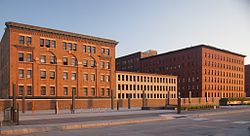Lowertown Historic District (Saint Paul, Minnesota)
|
Lowertown Historic District
|
|

Commercial buildings of the Lowertown Historic District
|
|
| Location | Roughly bounded by Kellogg Blvd, Broadway, 7th, and Jackson Sts., Saint Paul, Minnesota |
|---|---|
| Coordinates | 44°56′57″N 93°5′13″W / 44.94917°N 93.08694°W |
| Area | 35.5 acres (14.4 ha) |
| Built | 1870–1921 |
| Architect | Multiple |
| Architectural style | Late 19th and 20th Century Revivals, Late Victorian |
| NRHP Reference # | 83000935 |
| Added to NRHP | February 21, 1983 |
The Lowertown Historic District is a historic district in the Lowertown neighborhood of Saint Paul, Minnesota, United States. This 16-block warehouse and wholesaling district comprises 37 contributing properties built 1870s–1920. It was listed on the National Register of Historic Places in 1983 for the significance of its river and rail connections, economic impact, architecture, and urban planning. Lowertown was originally the lower landing on the Mississippi River; the first port of access to the Twin Cities. Several warehouse, railroad, banking, and distribution buildings served the entire Upper Midwest from 1880 to 1920. A significant concentration of these buildings survive, unified by similar architectural styles and construction materials. Many were designed by the city's most prestigious architects, including Cass Gilbert and Clarence Johnston, Sr.
The Lowertown neighborhood declined after the Depression. The renovation of the Merchant’s National Bank Building (now McColl Building) in the late 1960s was the first project to focus attention on revitalization potential. The conversion of the Noyes Brothers and Cutler Building into a complex of offices, shops, and restaurants (now known as Park Square Court) soon followed. The City’s Housing and Redevelopment Authority (HRA) became involved in 1973 when Mears Park was redesigned by William Sanders and renamed after Norman B. Mears, a Saint Paul businessman.
In April, 1978 the Lowertown Redevelopment Corporation (LRC) was organized with the goal of creating “a place for people, a highly livable urban village in the midst of the city, which will bring new jobs, housing, commercial development, and year round activities to Lowertown and infuse the city with renewed vitality.” Enabled by an unprecedented $10 million grant by the McKnight Foundation, the LRC assumed the role and responsibility of driving the revitalization of Lowertown. Throughout the 1970s and 1980s, artists moved to Lowertown, attracted by low rents, raw space and relative quiet. This new population began to bring life to the buildings and the streets of Lowertown. Initiated by the LRC and supported fully by the City of St. Paul, Lowertown was listed on the National Register of Historic Places in 1983; the next year, the City of St. Paul designated the Lowertown Historic District as a Heritage Preservation Site.
...
Wikipedia


